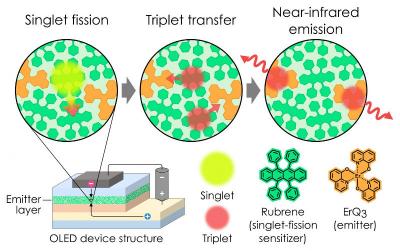Kyushu University researchers use singlet fission to achieve near-infrared OLED emitters with >100% IQE
Researchers from Japan's Kyushu University developed a new technology called singlet fission that enables near-infrared OLED materials to surpass the 100% limit for exciton production - or achieve an internal quantum efficiency (IQE) of over 100%. Singlet fission was already used in OPVs, but this is the first time that it was demonstrated with OLEDs.

Achieving over 100% is possible because at 100% IQE all charges form excitons that emit light. The new technique splits the energy from a high-energy excitons into two low level ones. The new OLED emitter materials use molecules in which singlets can transfer half of their energy to neighboring molecules while keeping half of the energy for themselves - each singlet creates two triplets. The emitters emit near-infrared light.




